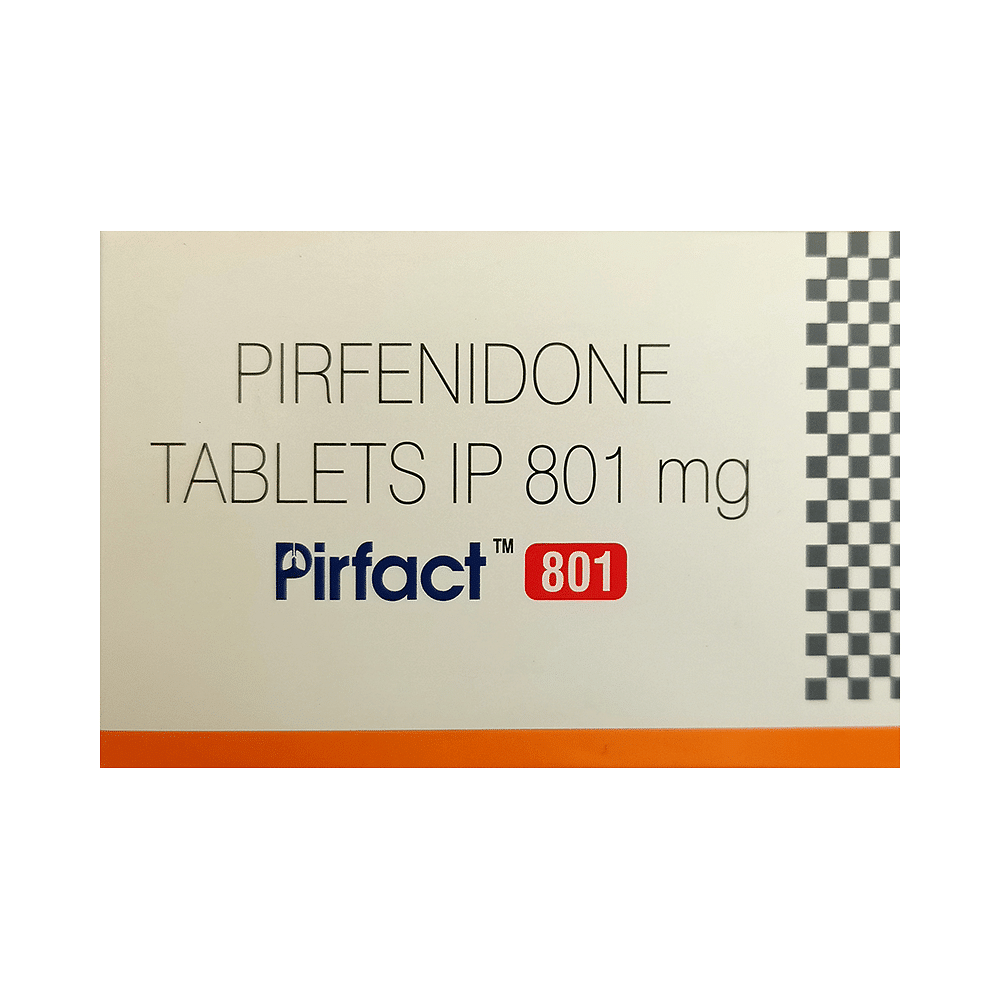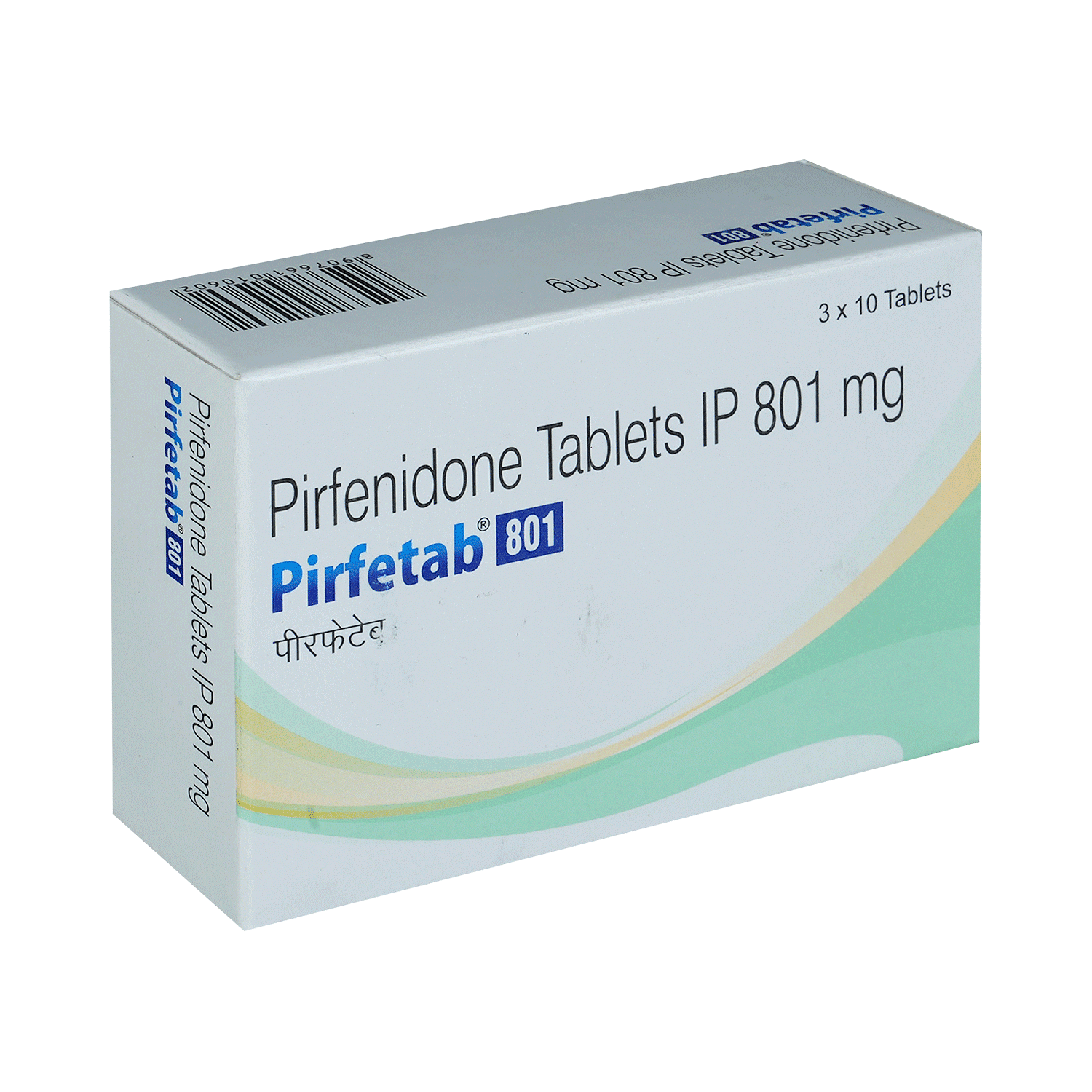
Fiboresp Forte Tablet
Manufacturer
Glenmark Pharmaceuticals Ltd
Salt Composition
Pirfenidone (801mg)
Key Information
Short Description
Fiboresp Forte Tablet is a prescription medicine used in the treatment of idiopathic pulmonary fibrosis. It reduces scarring and swelling in the lungs and helps to breathe better.
Dosage Form
Tablet
Introduction
Fiboresp Forte Tablet is best taken with food. Take it at the same time every day to get the most benefits. The dose and how often you take it depends on what you are taking it for. Your doctor will decide how much you need to improve your symptoms. You should take this medicine for as long as it is prescribed for you. The most common side effects of this medicine include insomnia, headache, dizziness, dyspepsia, nausea, diarrhea, and photosensitivity. To overcome dizziness, avoid driving or attention-seeking activity. Some people may experience weight loss and other side effects. Monitor your weight regularly or ask for the doctor's advice in such cases. Your doctor also may perform a liver function test while on treatment with this medicine. Before taking this medicine, let your doctor know if you have liver or kidney disease. Your doctor should also know about all other medicines you are taking as many of these may make this medicine less effective or change the way it works. It makes your skin sun-sensitive, wear protective clothing or apply sunscreen while in direct contact with the sun. Inform your doctor if you are pregnant or breastfeeding.
Directions for Use
Take this medicine in the dose and duration as advised by your doctor. Swallow it as a whole. Do not chew, crush or break it. Fiboresp Forte Tablet is to be taken with food.
Safety Information
Side Effects
insomnia headache dizziness dyspepsia nausea diarrhea photosensitivity
Alcohol Warning
It is not known whether it is safe to consume alcohol with Fiboresp Forte Tablet. Please consult your doctor.
Breastfeeding Warning
Information regarding the use of Fiboresp Forte Tablet during breastfeeding is not available. Please consult your doctor.
Pregnancy Warning
Fiboresp Forte Tablet may be unsafe to use during pregnancy. Although there are limited studies in humans, animal studies have shown harmful effects on the developing baby. Your doctor will weigh the benefits and any potential risks before prescribing it to you. Please consult your doctor.
How it works
Fiboresp Forte Tablet is an antifibrotic medication. It works by blocking the action of a certain natural substance in the body that is involved in causing fibrosis. This reduces the scarring and swelling in the lungs and makes breathing easier.
Quick Tips
Fiboresp Forte Tablet reduces scarring and swelling in the lungs and helps you breathe better. It is best to take this medicine with food and at the same time each day. It may make you more sensitive to sun. Use sunscreen and wear protective clothing when outdoors. Stop smoking during treatment with Fiboresp Forte Tablet as it can reduce the effect of the treatment. It may cause dizziness or sleepiness. Do not drive or do anything requiring concentration until you know how it affects you. It may cause weight loss. Monitor your weight regularly. Your doctor may check your liver function regularly. Inform your doctor if you develop abdominal pain, loss of appetite, darkened urine or yellowing of the eyes or skin (jaundice).
Related Medicines
Frequently asked questions
What monitoring will I need during treatment with Fiboresp Forte Tablet?
Before starting Fiboresp Forte Tablet, your doctor will check your liver function. This test will be repeated monthly for the first 6 months and then every three months. Additionally, your doctor will monitor your lung function periodically to assess your response to the medication.
Why is it important to continue treatment with Fiboresp Forte Tablet?
It's crucial to continue treatment with Fiboresp Forte Tablet to preserve existing lung function as this cannot be restored once lost. This helps control the progression of the disease and maintain a better quality of life.
What are the side effects of Fiboresp Forte Tablet?
Common side effects of Fiboresp Forte Tablet include skin sensitivity to sunlight, nausea, fatigue, diarrhea, indigestion, loss of appetite, and headache. Other common side effects include infections of the throat or airways, bladder infections, weight loss, difficulty sleeping, dizziness, sleepiness, changes in taste, hot flushes, shortness of breath, and cough. Additionally, some may experience stomach problems like acid reflux, vomiting, bloating, abdominal pain and discomfort, heart burn, constipation, skin issues such as itchy skin, redness, dry skin, rash, muscle pain, aching joints/joint pains, weakness, chest pain, and sunburn. It's also possible for blood tests to show increased liver enzyme levels after using Fiboresp Forte Tablet.
Is Fiboresp Forte Tablet a steroid?
No, Fiboresp Forte Tablet is not a steroid. It belongs to the pyridines group of medications and is used to treat idiopathic pulmonary fibrosis (IPF) in adults.
How do I know that Fiboresp Forte Tablet is right for me?
Only you and your doctor can determine if Fiboresp Forte Tablet is right for you. Your doctor will prescribe it after assessing your condition based on your response to treatment and tolerability. Continue taking the medication as prescribed by your doctor.
If my disease is stable, can I stop Fiboresp Forte Tablet?
Idiopathic pulmonary fibrosis is a progressive disease, though its progression is unpredictable. Please do not stop Fiboresp Forte Tablet without consulting your doctor. Continued use of the medication helps slow down the progression of the disease.
What should I avoid while taking Fiboresp Forte Tablet?
To minimize side effects, limit sun exposure when using Fiboresp Forte Tablet and wear sunscreen daily. Cover your arms, legs, and head to reduce sunlight contact. Additionally, avoid smoking as it can diminish the effectiveness of Fiboresp Forte Tablet.
What is the survival rate of pulmonary fibrosis?
The median survival of patients with pulmonary fibrosis is 2-3 years, though some live significantly longer. Factors that may shorten survival include older age, smoking history, and lower body mass index. Other factors can be a more severe extent of disease on imaging and physical impairment, along with the development of other lung complications or conditions.






